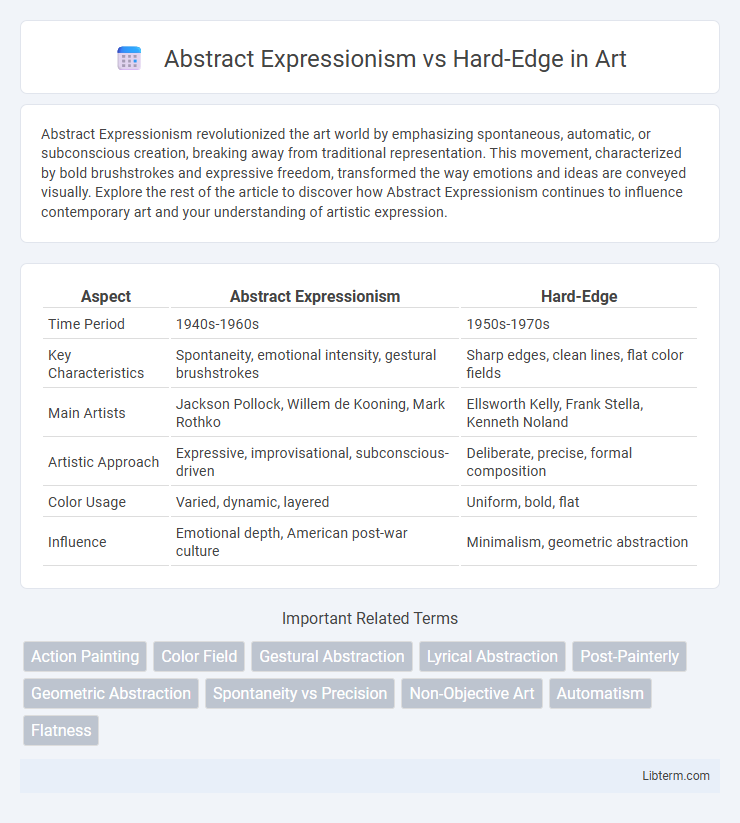Abstract Expressionism revolutionized the art world by emphasizing spontaneous, automatic, or subconscious creation, breaking away from traditional representation. This movement, characterized by bold brushstrokes and expressive freedom, transformed the way emotions and ideas are conveyed visually. Explore the rest of the article to discover how Abstract Expressionism continues to influence contemporary art and your understanding of artistic expression.
Table of Comparison
| Aspect | Abstract Expressionism | Hard-Edge |
|---|---|---|
| Time Period | 1940s-1960s | 1950s-1970s |
| Key Characteristics | Spontaneity, emotional intensity, gestural brushstrokes | Sharp edges, clean lines, flat color fields |
| Main Artists | Jackson Pollock, Willem de Kooning, Mark Rothko | Ellsworth Kelly, Frank Stella, Kenneth Noland |
| Artistic Approach | Expressive, improvisational, subconscious-driven | Deliberate, precise, formal composition |
| Color Usage | Varied, dynamic, layered | Uniform, bold, flat |
| Influence | Emotional depth, American post-war culture | Minimalism, geometric abstraction |
Introduction to Abstract Expressionism and Hard-Edge
Abstract Expressionism emerged in the 1940s as a revolutionary art movement characterized by spontaneous, gestural brushstrokes and an emphasis on emotional intensity, with key figures including Jackson Pollock and Willem de Kooning. Hard-Edge painting, developing in the late 1950s, contrasts this spontaneity through precise, clean lines and bold, flat color areas, exemplified by artists like Ellsworth Kelly and Frank Stella. Both movements reflect post-war American art's shift towards abstraction but differ fundamentally in technique and visual impact.
Historical Contexts and Origins
Abstract Expressionism originated in the 1940s and 1950s New York, rooted in post-World War II existential angst and a desire for personal expression through spontaneous, gestural brushstrokes. Hard-Edge painting emerged in the late 1950s and 1960s as a counter-movement, characterized by precise, clean lines and flat colors that rejected the emotional intensity of Abstract Expressionism. The historical shift from Abstract Expressionism to Hard-Edge reflects broader cultural changes, including a move toward minimalism and a focus on formalism in visual art.
Key Artists and Their Contributions
Abstract Expressionism, exemplified by key artists like Jackson Pollock and Willem de Kooning, emphasizes spontaneous, dynamic brushwork and emotional intensity, revolutionizing postwar American art through techniques such as action painting and gestural abstraction. Hard-Edge painting, associated with artists like Ellsworth Kelly and Frank Stella, contrasts this approach by employing crisp, geometric forms and flat, unmodulated colors that highlight precision and simplicity. These divergent methods reflect distinct philosophies in mid-20th-century art, with Abstract Expressionism prioritizing emotional expression and Hard-Edge focusing on formal clarity and structure.
Defining Characteristics of Abstract Expressionism
Abstract Expressionism is defined by its emphasis on spontaneous, gestural brushstrokes and an emotional intensity that conveys the artist's subconscious mind. The movement prioritizes large-scale canvases with dynamic compositions, often featuring non-representational or abstract forms to evoke raw emotion. In contrast to the precise, clean lines of Hard-Edge painting, Abstract Expressionism values texture, improvisation, and the physical act of painting as an essential part of the artwork's meaning.
Defining Characteristics of Hard-Edge
Hard-Edge painting is characterized by abrupt transitions between color areas, often employing geometric shapes and a flat, smooth application of paint that avoids visible brushstrokes. Unlike Abstract Expressionism's emphasis on spontaneous, gestural, and emotive techniques, Hard-Edge artists prioritize precision, clarity, and a controlled composition with clear delineations. This style emerged in the mid-20th century as a response to the expressive intensity of Abstract Expressionism, favoring sharp edges and uniform color fields to create a sense of order and structure.
Philosophical Underpinnings and Artistic Intentions
Abstract Expressionism embraces spontaneity and emotional intensity, emphasizing the artist's subconscious as a source of creativity, reflecting existential and individualistic philosophies. Hard-Edge painting prioritizes clarity, precision, and detachment, aiming for objective visual impact through clean lines and geometric forms, rooted in rationalism and formalism. Both movements diverge in their artistic intentions, with Abstract Expressionism seeking emotional resonance while Hard-Edge pursues intellectual order and aesthetic purity.
Techniques and Materials Used
Abstract Expressionism techniques emphasize spontaneous, gestural brushstrokes and thick impasto, often employing oil or acrylic paints on large canvases to convey intense emotion and movement. Hard-Edge painting uses precise, clean lines and flat, uniform fields of color, typically created with masking tape and acrylics to achieve sharp separations between shapes. Materials for Abstract Expressionism often include unconventional tools like palette knives and drip techniques, while Hard-Edge prioritizes synthetic brushes and stencils for rigorous geometric abstraction.
Visual Impact and Viewer Experience
Abstract Expressionism emphasizes spontaneous, dynamic brushstrokes and vibrant color fields that evoke intense emotional responses, creating a deeply personal visual impact. Hard-Edge painting contrasts with its precise, sharply defined shapes and smooth color transitions, fostering a more controlled, contemplative viewer experience focused on clarity and form. Both styles engage viewers differently: Abstract Expressionism invites emotional immersion, while Hard-Edge encourages intellectual appreciation of geometric abstraction.
Influence on Contemporary Art
Abstract Expressionism's emphasis on spontaneous, gestural brushwork and emotional intensity deeply influenced contemporary art by encouraging personal expression and breaking traditional compositional boundaries. Hard-Edge painting, characterized by sharp contours and precise color areas, contributed to contemporary art's exploration of minimalism, geometric abstraction, and spatial clarity. Both movements shaped modern visual language, with Abstract Expressionism inspiring emotive dynamism and Hard-Edge informing structured, flat surface aesthetics in contemporary practices.
Conclusion: Legacy and Lasting Impact
Abstract Expressionism revolutionized mid-20th century art by emphasizing spontaneous, emotionally charged brushwork and individual expression, deeply influencing generations of artists and expanding the possibilities of visual language. Hard-Edge painting responded with a precise, geometric abstraction characterized by clean lines and vivid color fields, shaping the development of Minimalism and modern design principles. Both movements left a profound legacy that continues to inspire contemporary art through their distinct approaches to form, emotion, and composition.
Abstract Expressionism Infographic

 libterm.com
libterm.com